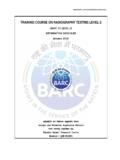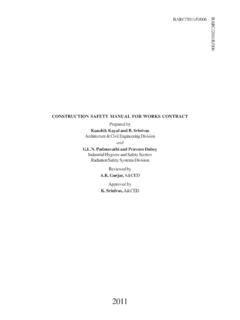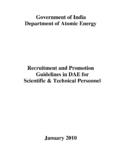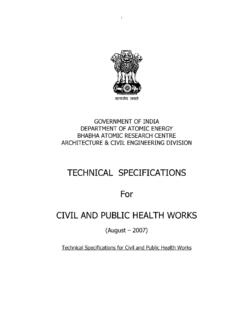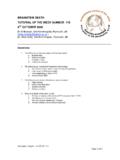Transcription of This book is intended solely to provide general guidelines ...
1 This book is intended solely to provide general guidelines for day to day practice in Medical Division, It is not intended to constitute legal counsel and should not be relied on as a source of legal advice. jksfx;ksa dh ns[kHkky ds fy, fpfdRlh; ekxZnf'kZdk MEDICAL guidelines . FOR PATIENT CARE. D J &% v Y i . Medical Division Y Y H jc C D v m bO v k b . BHABHA ATOMIC RESEARCH CENTRE. D C M k wl v i j, c yb F& - 400 094. Anushaktinagar, Mumbai - 400 094. peveJejer / January 2009. Published by Medical Division, BARC. Disclaimer This book is intended solely to provide general guidelines on a number of medical and legal issues. It is not intended to constitute legal counsel and should not be relied on as a source of legal advice.]
2 First Edition: January 2008. Second Edition: January 2009. Contributions All Doctors and Staff of Medical Division Compiled by Dr. Anita Gadgil Contact Numbers 022-2559 8249. 022-2559 8252. 022-2559 8154. Printed by Dr. Vijai Kumar Associate Director, Knowledge Management Group and Head, Scientific Information Resource Division Bhabha Atomic Research Centre, Trombay, Mumbai - 400 085. E mail: Computer Design, Graphics & Layout by Mr. Shahid Khan, SIRD, BARC. Cover Page Design by Mr. Kailash Gharat, RSSD, BARC. CONTENTS. Section I- Medico legal Cases-What, When and How 01. Section II- Casualty Protocols 1. general Medicine 07. 2. Respiratory Medicine 10. 3. Paediatrics 11. 4. general Surgery 21. 5. Orthopaedics 23. 6. Physiotherapy 27.
3 7. ENT 30. 8. Ophthalmology 32. 9. Gynaecology 33. 10. Psychiatry 34. Section III- Hospital Protocols & Policies 1. Working in Casualty 37. 2. Injury on Duty 41. 3. Indoor Patients 44. 4. Consent 49. 5. Operation Notes 52. 6. Infection Control guidelines 54. 7. Collection and Transportation of Clinical Material 60. 8. Blood Bank guidelines 65. 9. guidelines for Pharmacists 67. 10. guidelines for Disposal of Records Maintained in Medical Division 68. 11. Details of Panel Hospitals 70. 12. Drugs Available at Casualty 74. Section IV- Documents for Reference 1. Existing Medical Ethics Codes and Laws 77. 2. Legal Obligations of Doctors 88. 3. Important Telephone Numbers 93. iii 94. FOREWORD. On the occasion of the BARC Hospital day last year, Medical Division, BARC.
4 Brought out the first edition of the document, guidelines for Patient Care which was a very sincere effort to meet a long-standing need for specific procedures, protocols, suggestions and guidance to be followed by the medical professionals in BARC Hospital and peripheral dispensaries, during both regular practice as well as specific medical situations to ensure, ethical, efficient and effective healthcare to CHSS beneficiaries. Last year's book covered issues like consent of the patient, discharge at patient's request, referral to an appropriate panel hospital or specialist, preparation of OT notes, referral notes, critical care/intervention in ICCU, zero hour protocols, medico-legal cases, communication with the patients/their next of kin and right to information etc.
5 Some do's and don't s for medical professionals in our system were described. I am indeed very happy that this year the same document has been revised and updated with protocols and information on some new aspects of delivery of healthcare under CHSS. The current version incorporates guidelines for blood bank, pharmacists, handling of emergencies arising out of injuries suffered on duty, treatment casualty unit etc. Another interesting chapter pertains to information on Panel Hospitals, referral procedures and eligibility criteria which will be of immense help to doctors and patients alike. The attending doctors are required to be professionally up to date for handling critical situations such as an impending myocardial infarction and accident or a suicide.
6 There should not be a wrong prescription or dispensing of critical drugs or injection. Our professionals need to be educated on medico-legal cases. An attending doctor and hospital, providing the best possible attention in a given situation needs protection against suits alleging medical negligence. The modalities of diagnosis, treatment and critical care are changing given the spate of new developments in medical science. Both newly appointed as well as senior medical professionals have to be made aware of these additional demands on their duties while maintaining the high standards of professional conduct. Our health services are a major attraction to bright and talented prospective employees who shall have to shoulder the responsibilities of our ambitious R& D programmes in the years to come.
7 With the number of beneficiaries rising steadily, a stressful city life, changing life-styles, enhanced awareness of patients regarding latest treatments for chronic, life threatening and genetic and other complex disorders and diseases, the CHSS system is experiencing tremendous strain. The patients are demanding very expensive treatments based on information gathered from the internet or recommendation by specialists. The annual expenditure is mounting. Some of the treatments like monoclonal antibody therapy for cancer, growth factor inhibitors, anti-osteoporosis drugs, etc. are prohibitively expensive. Stem cells may sooner than later become a recommended treatment for several conditions involving cell and tissue losses.
8 Many who had opted out of CHSS long ago are desirous of rejoining the scheme. Geriatric care is posing acute problems with demands for prolonged hospitalization. These may, in future, lead to conflicts between the healthcare providers and v the beneficiaries. Therefore, a mechanism may have to be set up to regularly discuss the medical, socio-economic, financial and legal aspects of our healthcare system in a continuously changing scenario. Such a mechanism should also help evolve a policy on the CHSS obligation vis-a-vis expensive treatments. These guidelines , I am sure, will be updated periodically in future in this context. We need to realize that in a relatively well educated and well informed society of our CHSS beneficiaries, the doctors not only need to have an excellent professional knowledge but also the capacity for a well reasoned discussion with the beneficiary.
9 The paramedical staff must be equally adept and alert. The expectations of the DAE community are high. Delivery of an effective healthcare in a compassionate, ethical and efficient manner is thus an onerous task. It is not easy to make every patient or his/her next of kin feel that he/she has been best cared for. There are narrow windows of time of treatment for certain critical conditions. These guidelines will serve to make the best possible effort in that direction. I expect that at a later date these guidelines will be made available to all the hospitals and dispensaries working in different Units of DAE I compliment Medical Division for bringing out these revised and updated guidelines for patient care. (K. B. Sainis, Ph D).
10 Director, Bio-Medical Group vi ACKNOWLEDGEMENTS. We express our gratitude to all those who have contributed towards making this manual for ready reference in day-to-day functioning of Medical Division. The most valuable insight was offered in medico legal issues by Dr. Lalit Kapoor, Consulting Surgeon, Managing Trustee of Association of Medical Consultation and Chairman, Medico Legal Cell, Dr. Nikhil Datar, Medico Legal Consultant and Dr. Kamath, Medico Legal Consultant. They have inspired us in conceiving as well as scripting this manual. We are grateful to Dr. Lele, Retired Professor of Medicine in Govt. Colleges as well as Ex- Head, Nuclear Medicines, Jaslok Hospital for providing the information regarding legal obligation of doctors.


